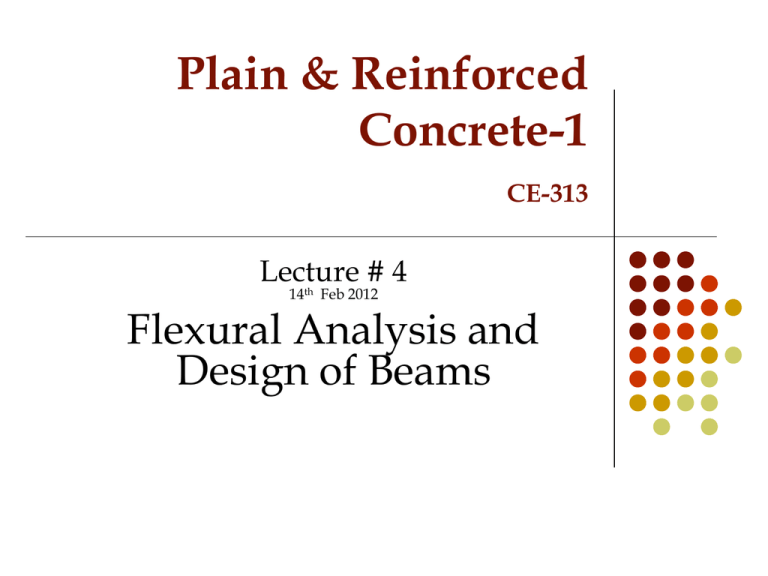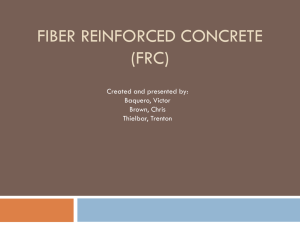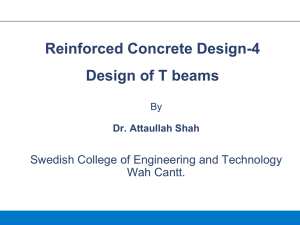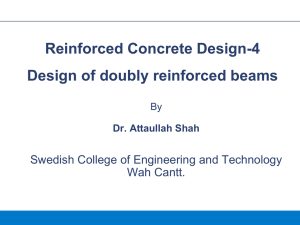Document
advertisement

Plain & Reinforced Concrete-1 CE-313 Lecture # 4 14th Feb 2012 Flexural Analysis and Design of Beams Plain & Reinforced Concrete-1 Flexural Behavior of Beams Under Service Load When loads are applied on the beam stresses are produced in concrete and steel reinforcement. If stress in steel bars is less than yield strength, steel is in elastic range. If stress in concrete is less than 0.6fc’ concrete is assumed to be with in elastic range. Following are important points related to Elastic Range: Loads are un-factored Materials are in elastic range All analysis and design are close to allowable stress analysis and design. Plain & Reinforced Concrete-1 Assumption for the Study of Flexural Behavior Plane sections of the beam remains plane after bending. The material of the beam is homogeneous and obeys hooks law Stress α Strain Perfect bond exists between steel & concrete so whatever strain is produced in concrete same is produced in steel. All the applied loads up to to failure are in equilibrium with the internal forces developed in the material. At the strain of 0.003 concrete is crushed. Plain & Reinforced Concrete-1 Assumption for the Study of Flexural Behavior (contd…) When cracks appear on the tension face of beam its capacity to resist tension is considered zero. Stress and strain diagrams for steel and concrete are simplified. 0.6fc’ Stress Stress Steel Strain Concrete Strain Plain & Reinforced Concrete-1 Flexural Behavior Beams General Procedure for the Derivation of Formula Step # 1 Draw the cross section of beam with reinforcement. Step # 2 Draw the strain diagram for the cross section. Step # 3 Draw the stress diagram. Step # 4 Show location of internal resultant forces. C T Step #5 Write down the equation for given configuration la Plain & Reinforced Concrete-1 Flexural Behavior Beams (contd…) 1. When Both Steel and Concrete are in Elastic Range εc εs Strain Diagram fc fs Stress Diagram C T la Resultant Force Diagram Both steel and concrete are resisting to applied action N.A. Plain & Reinforced Concrete-1 Flexural Behavior Beams (contd…) 2. When Cracks are Appeared on tension Side εc εs fc C fs Strain Diagram Stress Diagram T la N.A. Resultant Force Diagram When the tension side is cracked the concrete becomes ineffective but the strains goes on increasing. The steel comes in to action to take the tension. Plain & Reinforced Concrete-1 Flexural Behavior Beams (contd…) 3. When Compression Stresses Cross Elastic Range Stress fc’ 0.85fc’ Strain εc εs 0.85fc C fs Strain Diagram Stress Diagram T la N.A. Resultant Force Diagram It is clear that the stress diagram is infact obtained by rotating the stress strain diagram of concrete. Strains keeps on changing linearly in all three cases. Plain & Reinforced Concrete-1 Flexural Behavior Beams (contd…) Final Equation for Calculating Moment Capacity Mr = T x la = C x la Plain & Reinforced Concrete-1 Flexural/Bending Stress Formula f = ±My/I (Valid in Elastic Range Only) f = ±M/(I/y) f = ±M/S f = Flexural Stress S = Elastic Section Modulus Plain & Reinforced Concrete-1 Shear Stress Formula τ = VAY/(Ib) (Valid in Elastic Range Only) τ = VQ/(Ib) τ = Shear Stress Q = First moment of area First Moment of Shaded Area, Q = (b x d ) h b d h Plain & Reinforced Concrete-1 Notation b As’ (Compression Face) b hf d, Effective Depth h As (Tension Face) d bw fc = concrete stress at any load level at any distance form the N.A fc’= 28 days cylinder strength εc = Strain in concrete any load level εcu = Ultimate concrete strain, 0.003 Plain & Reinforced Concrete-1 Notation (contd…) fy = Yield strength of concrete fs = Steel stress at a particular load level εs = strain in steel at a particular level, εs = fs/Es εy = Yield strain in steel Es = Modulus of elasticity of steel Ec = Modulus of elasticity of concrete ρ,Roh = Steel Ratio, ρ = As/Ac = As/(bxd) T = Resultant tensile force C = Resultant compressive force Plain & Reinforced Concrete-1 Notation (contd…) b C h c=kd N.A la = jd d T jd = Lever arm j = la /d (valid for elastic range) kd = Depth of N.A. from compression face, j and k are always less than 1. k = c/d Concluded









